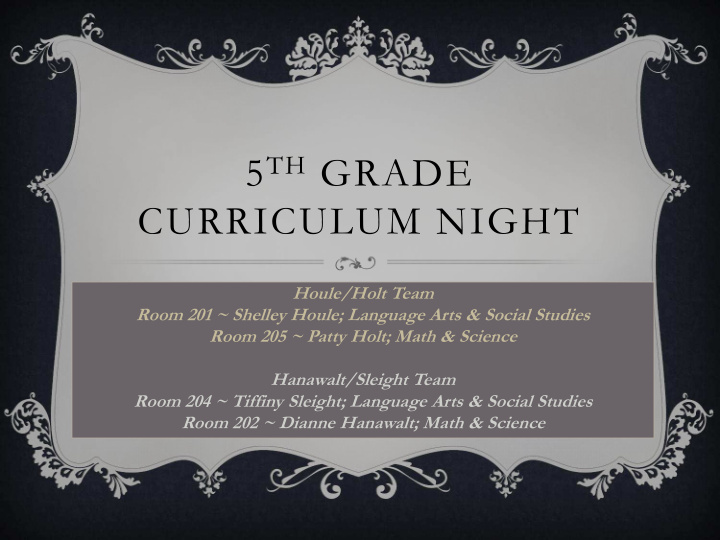



5 TH GRADE CURRICULUM NIGHT Houle/Holt Team Room 201 ~ Shelley Houle; Language Arts & Social Studies Room 205 ~ Patty Holt; Math & Science Hanawalt/Sleight Team Room 204 ~ Tiffiny Sleight; Language Arts & Social Studies Room 202 ~ Dianne Hanawalt; Math & Science
READING Reader’s Workshop Model • Teacher teaches targeted mini-lessons that meet state standards • Students self- select “just right” books to read silently • Students practice skills from mini-lessons using their own book or teacher selected passage • Teacher facilitates 1:1 conferencing and small guided groups Resources • Scott Foresman (CSD adopted anthology) • Storyworks magazine by Scholastic • Leveled books • Literature Studies (Holes, Tuck Everlasting, The Sign of the Beaver, and Mrs. Frisby and the Rats of NIMH
WRITING Writer’s Workshop Model • Teacher teaches targeted mini-lessons that meet state standards • Students practice writing in their journals • Teacher facilitates 1:1 conferencing and small guided groups Writing Forms • Personal Narratives • Report Writing • Informational Writing* • Persuasive Writing* *Mostly likely will be assessed on these two forms in future grades
TRADITIONAL SPELLING VS. SITTON Traditional Sitton Spelling • 20 words a week • Weekly words based on • Number varies each spelling patterns week • Words are different each • Words based on week targeted skills lessons • No emphasis on spelling and pulled from grade correctly in writing level priority and core words • Words are cycled… they keep popping up . Spelling is now part of the Writing grade on Report • Focused emphasis on Cards. An indicator score of 1, 2, 3, or 4 will be given proofreading skills and based on student achievement on spelling tests and spelling improving spelling in content areas (reading, within their writing. writing, science, etc.)
SOCIAL STUDIES In fifth grade, students use their understanding of social studies concepts and cause-and-effect relationships to study the development of the United States up to 1791. • History • Geography • Economics • Civics
SOCIAL STUDIES Areas of Study ~Development of Indigenous Societies ~First Contact with Europeans ~Explorers ~Colonization ~Rising Tensions between Colonies and Britain ~The Revolutionary War ~ The Constitution and Government
SCIENCE Grades 4 – 5 consists of nine Core Content Standards within the science domains. • Physical Science (force and motion, states of matter, and heat, light, sound and electricity) • Earth and Space Science (earth in space, formation of earth materials, and focus on fossils) • Life Science (structures and behaviors, food webs, and heredity and adaptation)
Within the context of several science lessons.. • Systems …how the parts of objects, plants, and animals are connected and work together. • Inquiry …conduct a variety of investigations. • Application …product of own design to solve a problem.
CAMAS DISTRICT FOSS kits • Matter and Energy • Landforms • Environments Human Growth and Development Class and teacher developed lessons!!
WA STATE MATH STANDARDS 5.1. Core Content: Multi-digit division (Operations, Algebra) S tudents learn efficient ways to divide whole numbers . 5.2. Core Content: Addition and subtraction of fractions and decimals (Numbers, Operations, Algebra) S tudents learn procedures for adding and subtracting fractions and decimals . 5.3. Core Content: Triangles and quadrilaterals (Geometry/Measurement, Algebra) C lassify, find area and perimeter , find shape symmetry.
MATH STANDARDS… 5.4. Core Content: Representations of algebraic relationships (Operations, Algebra) S tudents continue their development of algebraic thinking as they move toward more in-depth study of algebra in middle school. use variables to write simple algebraic expressions evaluate simple algebraic expressions make tables and graphs from linear
…MATH STANDARDS 5.5. Additional Key Content (Numbers, Data/Statistics/Probability) S tudents extend their work with common factors and common multiples as they deal with prime numbers . Students extend and reinforce their use of numbers, operations, and graphing to describe and compare data. 5.6. Core Processes: Reasoning, problem solving, and communication S tudents in grade five solve problems that extend their understanding of core mathematical concepts as they make strategic decisions leading to reasonable solutions.
CAMAS DISTRICT CURRICULUM Math Connects • Daily lessons, daily practice, benchmark and unit tests. • On-line support at http://www.macmillanmh.com/math/mathconne cts/wa/index.html
STANDARDS PRACTICE SITE IXL at www.ixl.com • Individualized practice of Common Core Standards • Student access through username and password • Teacher/parent/student can monitor progress
Recommend
More recommend